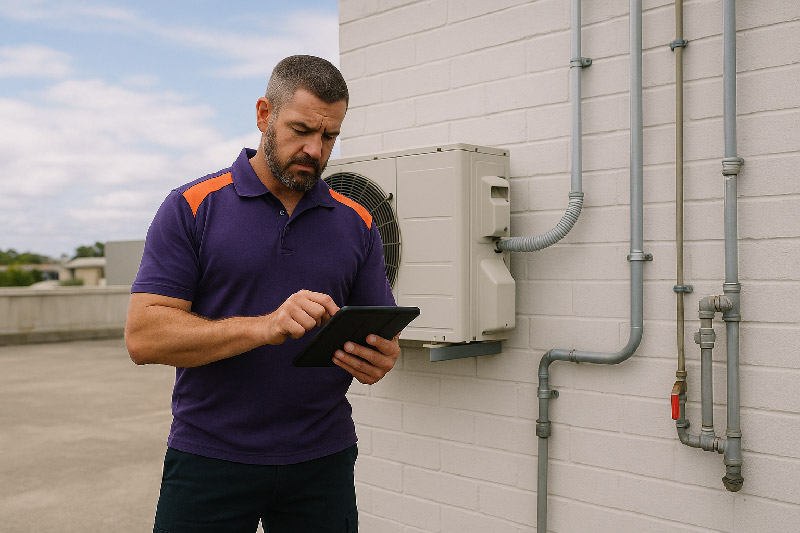Industrial Ventilation Maintenance: A Comprehensive Guide for HVAC Companies

Industrial ventilation systems play a crucial role in maintaining a safe and healthy working environment in the commercial HVAC field.
To ensure their efficient operation and longevity, regular maintenance is essential. In this blog post, we will delve into the importance of industrial ventilation maintenance and provide a comprehensive overview of the key components that require routine attention.
Additionally, we will highlight the significance of preventive and predictive maintenance, discuss the role of cleaning and lubrication, emphasize the importance of routine inspections and health check-ups, and explore the benefits of being prepared for unexpected setbacks.
Finally, we will showcase how FieldInsight’s asset management software can streamline and optimize industrial ventilation maintenance tasks.
Understanding Industrial Ventilation Systems
Industrial ventilation systems consist of several crucial components that require routine maintenance to ensure their optimal performance. These include ductwork, fans, filters, and controls.
Ductwork plays a vital role in distributing air throughout the facility, and any leaks or blockages can hamper the system’s efficiency.
Fans are responsible for moving air, and their blades, motors, and belts need regular inspection and lubrication. Filters play a critical role in capturing contaminants and require frequent replacement or cleaning.
Finally, controls, such as sensors and switches, need to be inspected and calibrated to maintain accurate operation.
The Importance of Regular Industrial Ventilation Maintenance
Regular maintenance is key to the efficient operation and lifespan of industrial ventilation systems and ventilation equipment. Neglecting maintenance can lead to various risks and costs. For instance, clogged filters can reduce airflow, and ventilation system problems, leading to decreased system efficiency and increased energy consumption.
Dust accumulation in ductwork can restrict air movement and promote the growth of harmful microorganisms. Corrosion and wear and tear on components can result in breakdowns and costly repairs.
Additionally, poor indoor air quality or air flow from issues such as clogged air cleaner can lead to health issues for employees, resulting in decreased productivity and potential legal liabilities.
Essential Checks for Industrial Ventilation Systems
To prevent breakdowns and ensure optimal performance, several essential maintenance tasks should be performed regularly. These include checking for leaks in ductwork, inspecting and lubricating fan blades, motors, and belts, cleaning or replacing filters, and inspecting controls for proper operation.
It’s also crucial to assess the overall condition of the system, looking for signs of corrosion, dust accumulation, and wear and tear on moving parts. By addressing these maintenance tasks proactively, the risk of system failures and associated costs can be significantly reduced.
The Role of Preventive and Predictive Maintenance in Industrial Ventilation Systems
Preventive and predictive maintenance strategies are instrumental in maximizing the longevity and efficiency of industrial ventilation systems.
Preventive maintenance involves performing routine tasks at scheduled intervals to prevent potential issues. Predictive maintenance, on the other hand, relies on data analysis and advanced technologies to identify potential failures before they occur.
By implementing a combination of preventive and predictive maintenance, facility managers can optimize their maintenance efforts and minimize downtime. FieldInsight’s asset management software is an invaluable tool that can aid in both preventive and predictive maintenance by streamlining task scheduling, data collection, and analysis.
The Significance of Regular Cleaning and Lubrication
Regular cleaning and lubrication are essential aspects of industrial ventilation preventive maintenance. Cleaning ensures the removal of dust, debris, and contaminants that can accumulate in ductwork, fans, and filters. This not only improves system efficiency but also contributes to better indoor air quality. Lubrication of fan blades, motors, and belts reduces friction and wear, promoting smoother operation and extending the lifespan of these components. When performing cleaning and lubrication tasks, it’s important to follow manufacturer guidelines and use appropriate cleaning agents and lubricants.
The Importance of Routine Inspections and Health Check-ups
Routine inspections and health check-ups are vital for maintaining the efficiency of an industrial ventilation system. Inspections allow for the early detection of issues such as leaks, corrosion, and wear and tear on components.
Additionally, regular health check-ups assess the overall performance of the system, including airflow rates, pressure differentials, and air quality measurements. By identifying and addressing potential problems promptly, facility managers can prevent costly breakdowns and ensure the system continues to operate optimally. FieldInsight’s software simplifies the inspection process by providing digital checklists, facilitating data recording, and generating comprehensive reports.
Preparing for Unexpected Setbacks: The Role of Spare Components and Emergency Repairs
Being prepared for unexpected setbacks is crucial in industrial ventilation maintenance. This includes having spare components readily available to minimize downtime in case of failures. Maintaining an inventory of critical parts, such as fan motors or control switches, ensures quick replacements when needed.
Additionally, establishing emergency repair procedures and training staff on swift response protocols can help mitigate the impact of unexpected failures. FieldInsight’s software can assist in managing and tracking spare components, ensuring inventory levels are optimized and facilitating seamless emergency repair processes.
Leveraging FieldInsight for Industrial Ventilation Maintenance
FieldInsight’s comprehensive features make it an invaluable tool for managing industrial ventilation maintenance. The software enables facility managers to schedule and track maintenance tasks efficiently, ensuring that routine checks and servicing are conducted on time. By providing real-time updates and notifications, it keeps maintenance teams informed and allows for prompt response to issues.
Furthermore, FieldInsight’s asset management capabilities help track the lifespan and performance of ventilation system components, facilitating proactive replacement and reducing unexpected failures. Overall, FieldInsight streamlines the maintenance process, improves operational efficiency, and enhances the longevity of industrial ventilation systems.
Takeaways for your industrial ventilation system
Industrial ventilation maintenance is essential for ensuring the efficiency and longevity of ventilation systems. By performing routine maintenance tasks, such as cleaning, lubrication, inspections, and health check-ups, potential issues can be identified and addressed proactively, reducing risks and costs associated with system failures. Implementing a combination of preventive and predictive maintenance strategies further optimizes maintenance efforts.
FieldInsight’s asset management software streamlines the entire maintenance process, from scheduling tasks to tracking assets and providing real-time updates. With FieldInsight, facility managers can maximize the performance and lifespan of their industrial ventilation systems, creating a safe and healthy working environment while minimizing downtime and costs.
What You Should Do Now
- Book a Demo. You’ll be in touch with an automation expert who has worked in this space for over 5 years, and knows the optimal workflow to address your needs.
- If you’d like access to free articles about managing HVAC workflows, go to our blog.
- If you know someone who’d enjoy reading this page, share it with them via email, Linkedin, Twitter, or Facebook.








